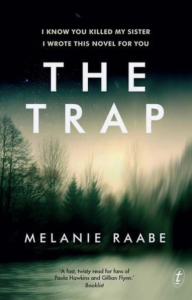
The Trap, Melanie Raabe’s debut novel, was published exactly ten years ago. Several publishers went to auction to get it and it was translated into 16 languages. Quite impressive for a German thriller. Thrillers aren’t my favorite crime genre but when done well I still enjoy them a lot. I looked forward to reading this as the premise sounded interesting.
Linda Conrads, a very famous literary novelist, hasn’t left her villa overlooking the Starnberger See near Munich, for over eleven years. Most people think she’s suffering from a mysterious illness. Nobody but her parents and some friends know the real reason behind her isolation. Linda has been deeply traumatized by the death of her sister. Not only was her sister murdered and Linda found her in a pool of blood, but she also saw the killer. Only briefly but well enough to be haunted by his face in her dreams. Even though she saw the killer of her sister, the police never found him. They even suspected Linda might have killed her. Maybe they weren’t as fond of each other as everyone said.
At the beginning of the novel, Linda is watching TV and to her shock, there he is, the killer of her sister. It looks like he’s a famous news reporter. What now? Should she involve the police? Initially she tries to but then decides against it. She will set a trap for him.
Her plan is quite elaborate so she cannot do it right away. She first has to write a novel. A novel about her sister’s murder. Once it is finished and before the book is published she contacts the newspaper for which the journalist works and offers him an exclusive interview. She knows it’s a gamble because he’s not usually reviewing books or interviewing authors, but he accepts.
The journalist arrives with a photographer and Linda’s young assistant is also in the house but once she’s gotten rid of both she begins with the execution of her plan. What follows is told in a dual narrative. Parts are describing how Linda confronts the journalist, the other parts consist of the crime novel she has written. The more the confrontation progresses, the more the reader begins to wonder who really killed Linda’s sister.
I’m sorry to say that I didn’t like this book. I hated the writing. The book is written from Linda’s point of view who is said to be a literary writer. It looks like that’s why Melanie Raabe felt the urge to use a lot of similes one worse than the other. They all came from the kitchen cupboard. The air was like gelatine, the sky like jam, . . . That sort of thing. Annoying and heavy handed. And anything but literary.
I also found the main character unbelievable and unlikable. The character is constantly imagining situations and the reader only finds out afterwards, that it isn’t real. It’s also not always clear whether this is just the way she is or whether she is truly confused. Obviously, this is done on purpose, to confuse the reader.
Why was this so successful? It’s frustrating to think that, once again, a great premise, a few good introductory pages, and great marketing were all it needed for a success.
